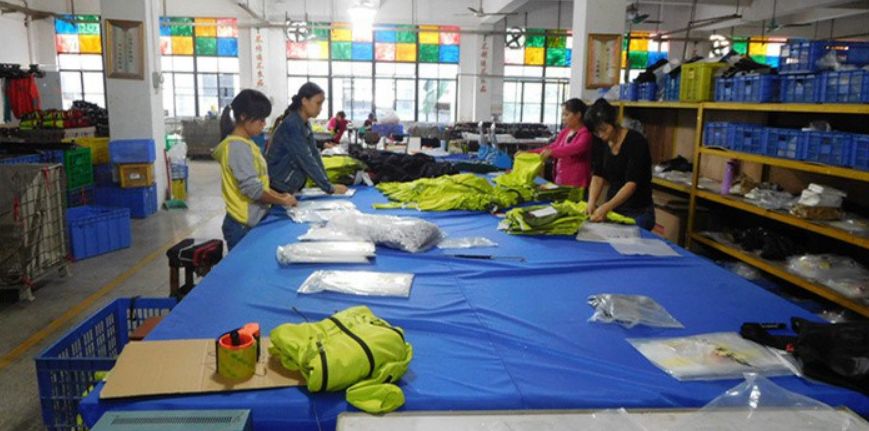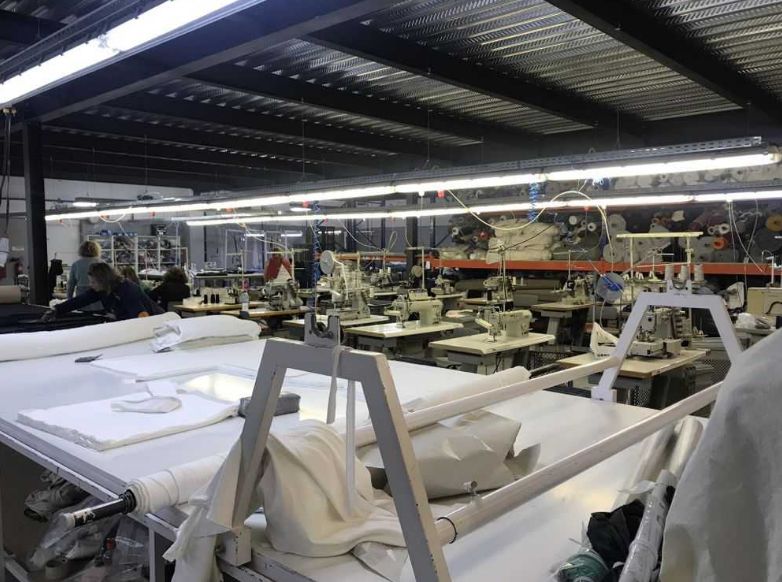Dive into the world of sustainable sports wear; our goal, to unveil its role in sports wear manufacturing. Quality control, a linchpin in this realm, gets the spotlight. Here, we'll dissect how it upholds the integrity of sustainable sports wear. Expect a journey through meticulous standards, eco-friendly materials, and innovative practices. This blog navigates the labyrinth of quality in the sports wear industry.

In sports wear, QC (Quality Control) is paramount. Fabric resilience in jerseys, vital! Athletes demand durability and comfort. Microfibers used must be top-notch, resisting wear and tear. Stitching precision: non-negotiable. Each seam has a testament to meticulous craftsmanship.
In sports, equipment failure isn't an option. Thus, QC ensures peak performance attire. It's not just about looks; it's about longevity and reliability. Athletes' safety hinges on the integrity of their gear. Quality sports wear is an investment in an athlete's potential.

In sustainable sports wear, longevity reigns. Fabrics like Cordura resist abrasion; vital in outdoor gear. Stitching matters: Reinforced seams endure. Durability's not a mere trend; it's a commitment to less waste. Eco-warriors seek gear that outlasts seasons.
Freedom of movement is a cardinal rule in sustainable attire. Spandex, a hero; stretching, not snapping. Eco-flex fabrics blend nature's gifts: organic cotton and elastane. Imagine yoga pants, bending without breaking, embracing every pose. Flexibility isn't luxury, its necessity.
Comfort a silent whisper in fabric's embrace. Bamboo fibers, soft as a morning breeze, caress the skin. Zero-irritation and high-performance - sustainable wear's promise. Jogging or lounging, comfort's non-negotiable. Sustainable comfort is a gentle footprint on Earth, a soft touch on skin.
Breathability is Nature’s air conditioning in fabric form. Tencel™, a champion, wicks away life's humidity. Micro-ventilation has an unseen art in sports wear. When heat battles cool, breathable fabrics mediate. Sustainable wear breathes, keeping the athlete and the planet cool.
Moisture-wicking is a silent combatant against sweat's tyranny. Cocona fabric, infused with coconut shells, battles moisture. Athletes stay dry, environments stay unharmed. Sweat departs, comfort stays - the magic of sustainable technology. Moisture-wicking, not just a feature, it's a savior.
Aesthetics in eco-gear is a dance of color and conscience. Recycled polyester, vibrant yet virtuous. Style meets sustainability; fashion with a cause. Sustainable doesn't mean bland; it's a rainbow of eco-chic.
In the sustainable sportswear, fabric integrity is scrutinized meticulously. Fibers, examined through microscopes, reveal a tapestry of eco-friendly threads. Thread counts, dye adherence, and weave uniformity undergo rigorous inspection protocols.
Infrared scanners detect flaws invisible to the human eye. Each garment, a symphony of precision, echoes our commitment to sustainability.
Stress tests, simulating extreme athletic scenarios, push the limits of eco-fabrics. Tensile strength, measured in Newtons, must surpass stringent benchmarks. Water resistance, gauged through droplet absorption rates, confirms outdoor resilience.
Abrasion trials, conducted over 10,000 cycles, ensure durability. Each test, a crucible, forges sportswear that withstands the test of time and tide.
Compliance, a cornerstone in sustainable sportswear, adheres to ISO 14001 standards. Carbon footprint analysis, conducted bi-annually, measures environmental impact.
Recyclability rates, tracked for each material, bolster eco-consciousness. Ethical sourcing, verified by third-party audits, ensures a guilt-free supply chain. Compliance is not just a goal; it's our ethical compass.
Precision tools, calibrated bi-weekly, maintain accuracy. Torque wrenches and fabric tension gauges, aligned to micrometric standards, ensure product consistency.
Humidity-controlled environments protect sensitive materials. Calibration logs, detailed meticulously, provide a historical record of accuracy. In this precision, we find the essence of quality.
Documentation, meticulously maintained, chronicles the sustainable journey. Material Safety Data Sheets (MSDS), for each eco-fabric, detail environmental impact.
Process flowcharts, updated quarterly, illustrate efficiency improvements. Certificates of Compliance (COC) accompany every batch. This paperwork is not mere bureaucracy; it's the narrative of our eco-commitment.
Continuous monitoring, utilizing state-of-the-art sensors, tracks production anomalies. Real-time data is displayed on dashboards, guide swift decision-making.
Machine learning algorithms predict maintenance needs, reducing downtime. Environmental conditions, logged hourly, ensure optimal manufacturing settings. Through vigilant monitoring, we safeguard our pledge to sustainability.
Planning, the blueprint of quality control incorporates Six Sigma methodologies. Sustainable goals, woven into project plans, prioritize eco-efficiency.
Risk assessments, updated monthly, identify potential pitfalls. Resource allocation, mindful of the environmental footprint, balances efficiency with conservation. In this planning, we lay the groundwork for sustainable success.
Procedures, the backbone of quality control, are scripted with precision. Standard Operating Procedures (SOPs) for each task ensure uniformity.
Control charts, tracking key performance indicators (KPIs), maintain high standard. Continuous improvement cycles, inspired by Kaizen, refine processes. These procedures aren't just steps; they're strides towards excellence.
Training, tailored to foster eco-awareness, empowers employees. Virtual reality simulations, imitating real-life scenarios, enhance skill sets.
Knowledge sharing sessions, conducted bi-weekly, foster a culture of continuous learning. Certification programs, focused on sustainable practices, elevate expertise. Training is not just learning; it's an evolution of consciousness.
Tools, chosen for precision and sustainability, augment quality control. 3D scanners assess product dimensions with laser accuracy.
Biodegradable cleaning agents preserve equipment integrity. Energy-efficient machines, audited annually, reduce carbon footprints. These tools are not mere instruments; they're extensions of our eco-ethos.
Auditing, a critical eye on processes, ensures compliance. Internal audits, conducted quarterly, uncover process gaps. Supplier audits, scrutinizing eco-credentials, maintain a green supply chain. Audit reports, detailed and action-oriented, drive improvements. Auditing is not just evaluation; it's a quest for perfection.
Feedback, gathered from end-users, shapes future innovations. Online surveys, analyzing customer satisfaction, reveal insights. Focus groups, discussing wear and tear, inform durability enhancements. Suggestion boxes, encouraging employee ideas, foster a creative atmosphere. Feedback is not just opinions; it's the voice of progress.
|
Quality Control Aspect |
Planning (P) |
Procedures (PR) |
Training (TR) |
Tools (T) |
Auditing (A) |
Feedback (F) |
|
Objective |
Define QC goals |
Establish QC steps |
Enhance skills |
Equip workforce |
Ensure compliance |
Improve processes |
|
Key Activities |
Goal setting, risk assessment |
Documentation, SOPs creation |
Skill development, workshops |
Selection, calibration |
Inspections, reports |
Analysis, action plan |
|
Metrics |
Milestones, timeline |
SOP adherence rate |
Training hours, pass rate |
Tool uptime, efficiency |
Non-compliance rate |
Improvement rate |
|
Resources Needed |
Strategic plan, data |
Manuals, guidelines |
Instructors, modules |
Hardware, software |
Auditors, checklist |
Surveys, feedback systems |
|
Outcome |
Strategic alignment |
Process uniformity |
Competency |
Operational efficiency |
Compliance assurance |
Process optimization |
|
Challenges |
Resource allocation |
Standardization |
Engagement level |
Tech compatibility |
Objective evaluation |
Timely response |
|
Tech Applications |
Project Mgmt. Software |
Process Mining Tools |
E-learning platforms |
IoT, AI tools |
Audit Mgmt. Software |
CRM, BI tools |
A Table On How To Set Up An Effective Quality Control System!

In sustainable sports wear, QC audits are pivotal. They ensure uniformity in eco-friendly fabric use. Audits verify thread count, fabric blend ratios, and dye quality. Regular checks maintain product uniformity, vital for brand reputation.
Eco-fibers like TENCEL™ must meet strict consistency criteria. Without audits, variations in material strength and comfort could arise. Each garment reflects a commitment to uniform quality and environmental stewardship. Consistent testing protocols are the backbone of sustainable production.
Standards in sustainable sports wear production are non-negotiable. QC audits uphold ISO 14001 environmental management norms. These audits scrutinize every aspect, from recycled polyester to organic cotton. Ensuring adherence to Global Organic Textile Standard (GOTS) is crucial.
Audits prevent deviations from established eco-friendly benchmarks. They ensure every product aligns with the Sustainable Apparel Coalition’s guidelines. Standards like Bluesign are rigorously applied during these audits. This maintains the integrity of sustainable sports wear.
Continuous improvement is the mantra in sustainable sports wear. Regular audits identify areas for enhancement. Feedback loops from QC audits drive innovation in fabric technology. Audits lead to advances in moisture-wicking and breathability features.
They push boundaries in sustainable material development, like Mylo™ (mushroom leather). QC findings catalyze improvements in energy-efficient production methods. Each audit is a stepping stone towards more sustainable practices. They foster a culture of perpetual advancement in sports wear sustainability.
Compliance is the cornerstone of sustainable sports wear production. QC audits ensure adherence to Fair Labor Association (FLA) standards. They verify compliance with environmental regulations, such as REACH in the EU. Audits check for alignment with Zero Discharge of Hazardous Chemicals (ZDHC) protocol.
They ensure factories follow Responsible down Standard (RDS) for ethical sourcing. Compliance with these standards is non-negotiable for eco-conscious brands. Regular audits are the guardians of ethical and sustainable compliance.
Transparency is crucial in the sustainable sports wear realm. QC audits provide insight into production processes. They reveal the origins of organic fibers and recycled materials. Audits offer a window into the energy consumption of factories.
They showcase efforts in reducing water wastage during production. Transparency through audits builds trust with eco-conscious consumers. It demonstrates a brand's commitment to environmental responsibility. Audits are the lens through which sustainable practices are viewed and validated.
Verification is key to maintaining sustainable sports wear's integrity. QC audits verify claims of organic material usage. They confirm the presence of certifications like OEKO-TEX® Standard 100.
They ensure that eco-claims are not mere green washing tactics. Verification through audits is essential for consumer trust. It underlines a brand's dedication to true sustainability. In the world of eco-apparel, verification is the seal of authenticity.

In the sustainable sportswear, dimensional fidelity reigns supreme. Ensuring XS, S, M, L, XL, and XXL sizes mirror exact measurements requires rigorous standardization protocols.
Fabric GSM (Grams per Square Meter) and thread count must be identical across batches. A harmonized color palette, utilizing standardized Pantone references, guarantees uniformity. Zippers, buttons, and seams: each component meticulously matched. This adherence to standardization underpins the essence of mass production: reproducibility and consistency.
Automation, the linchpin in mass-producing sustainable sportswear, introduces precision and speed. Robotics, guided by sophisticated AI algorithms, ensures stitch perfection in every garment. CAD (Computer-Aided Design) systems facilitate rapid prototyping, minimizing human error.
Efficiency scales up as machines tirelessly cut, sew, and assemble. Automated quality control systems, equipped with advanced sensors, detect even minuscule defects. Automation not only accelerates production but elevates quality standards, a must for sustainability.
Sampling is a crucial phase, akin to a litmus test for sustainable sportswear. Initial prototypes undergo rigorous testing; stress tests ensure endurance. Color fastness and fabric pilling are scrutinized under diverse conditions. Adjustments in design or material composition often follow.
Through this iterative process, sampling shapes the final product, ensuring it meets the high bar set for sustainable sportswear.
Batch testing, a critical checkpoint, ensures consistency in sustainable sportswear production. Each production run faces a gauntlet of tests: tensile strength, moisture-wicking capability, UV resistance.
Spectrophotometers measure color accuracy, ensuring no deviation. Thermal regulation properties are tested under controlled environmental conditions. Only batches passing these stringent tests proceed to market. This relentless commitment to quality testing upholds the integrity of sustainable sportswear.
Process control in sustainable sportswear manufacturing is akin to a symphony conductor's role. Raw material sourcing adheres to strict environmental standards. Production line speeds, temperature, humidity - all under constant surveillance.
Real-time data feeds into a central system, enabling swift corrective actions. Lean manufacturing principles are applied to minimize waste. This meticulous process control ensures each garment is not just a piece of clothing, but a testament to sustainable engineering.
Traceability in sustainable sportswear offers transparency, building trust. From organic cotton fields to the loom, every step is documented. Blockchain technology captures and stores this data securely. QR codes on labels provide consumers with a garment's life story.
This traceability isn't just about accountability; it's a narrative of sustainability. Knowing the origin of each thread weaves a deeper connection between the product and its consumer, fostering responsible consumption.
In sports wear, data reigns supreme. Advanced analytics dissect materials for endurance, scrutinizing fabric resilience via stress-tests (ST-200). Spectral analysis (SA-890) pinpoints color fastness. Sustainability metrics, measured in Eco-Index Points (EIP), guide fabric selection.
Numbers narrate the tale of durability and eco-friendliness. Data visualization tools, like DV-Matrix, reveal hidden patterns in wear-and-tear. Predictive algorithms forecast lifespan, ensuring longer-lasting gear. Analytics transform raw numbers into actionable sustainability insights.
Robotic arms, programmed with Precision Stitching Algorithms (PSA), deliver uniform seams. Automated Cutting Units (ACU-5000) slice fabrics with millimeter accuracy. Robotics brings consistency to sports wear crafting. Assembly-line robots, equipped with sensors, detect defects in real-time.
In sustainability, robots reduce waste, optimizing material usage. Customizable Robotic Systems (CRS) adapt to various fabric types, from organic cotton to recycled-high polyester. Eco-efficient robotics embodies the fusion of technology and sustainability.
AI revolutionizes sports wear production, merging sustainability with innovation. Machine Learning Models (MLM) predicts optimal fabric blends, balancing performance and biodegradability.
AI-driven design tools suggest patterns that minimize offcuts. AI algorithms analyze consumer trends, shaping eco-friendly collections. Intelligent Systems (IS) manage inventory, reducing overproduction. AI, the digital alchemist, turns data into eco-conscious sports apparel. With AI, sustainable sports wear becomes a tangible reality.
IoT devices monitor factory conditions, ensuring ethical manufacturing standards. Sensors track humidity and temperature, preserving fabric integrity. IoT-enabled machinery adjusts energy usage, slashing carbon footprint. Real-time tracking systems (RTTS) oversee supply chain sustainability.
IoT bridges the gap between digital efficiency and ecological responsibility. Smart tags in garments store lifecycle data, enhancing transparency. IoT, a silent guardian watches over every stitch is in sustainable sports wear.
Biometrics tailor sports wear to individual physiology. Pressure-sensitive fabrics (PSF) adapt to muscle movement, enhancing performance. Thermoregulatory materials react to body heat, offering comfort.
Biometric data guide design, ensuring ergonomic fit. Wearable sensors collect fitness metrics, a boon for athletes. Eco-conscious materials meet personalized functionality. Biometrics, in sports wear, creates a symphony of comfort, performance, and sustainability.
Nanotechnology weaves magic into sports wear. Nano-coatings repel water and dirt, extending garment life. Nano-fibers enhance breathability, without compromising durability. Nanotech infuses fabrics with antimicrobial properties, reducing wash frequency.
Self-healing materials (SHM) patch micro-tears, a leap in sustainability. Nanotech, a microscopic miracle worker, redefines the boundaries of sustainable sports wear. Through nanotech, apparel transcends traditional limits, embodying resilience and ecological harmony.
Sustainable sports wear emerges as a pivotal factor in the quality sports apparel. SansanSports, through meticulous quality control, ensures durability and eco-friendliness. Visit SANSANSPORTS for products that blend innovation with sustainability.
Their attire stands as a testament to the harmonious blend of technology and nature. Echoing the ethos of responsibility, each garment whispers a story of environmental stewardship. Sustainable sports wear isn't just a choice; it's a statement.
